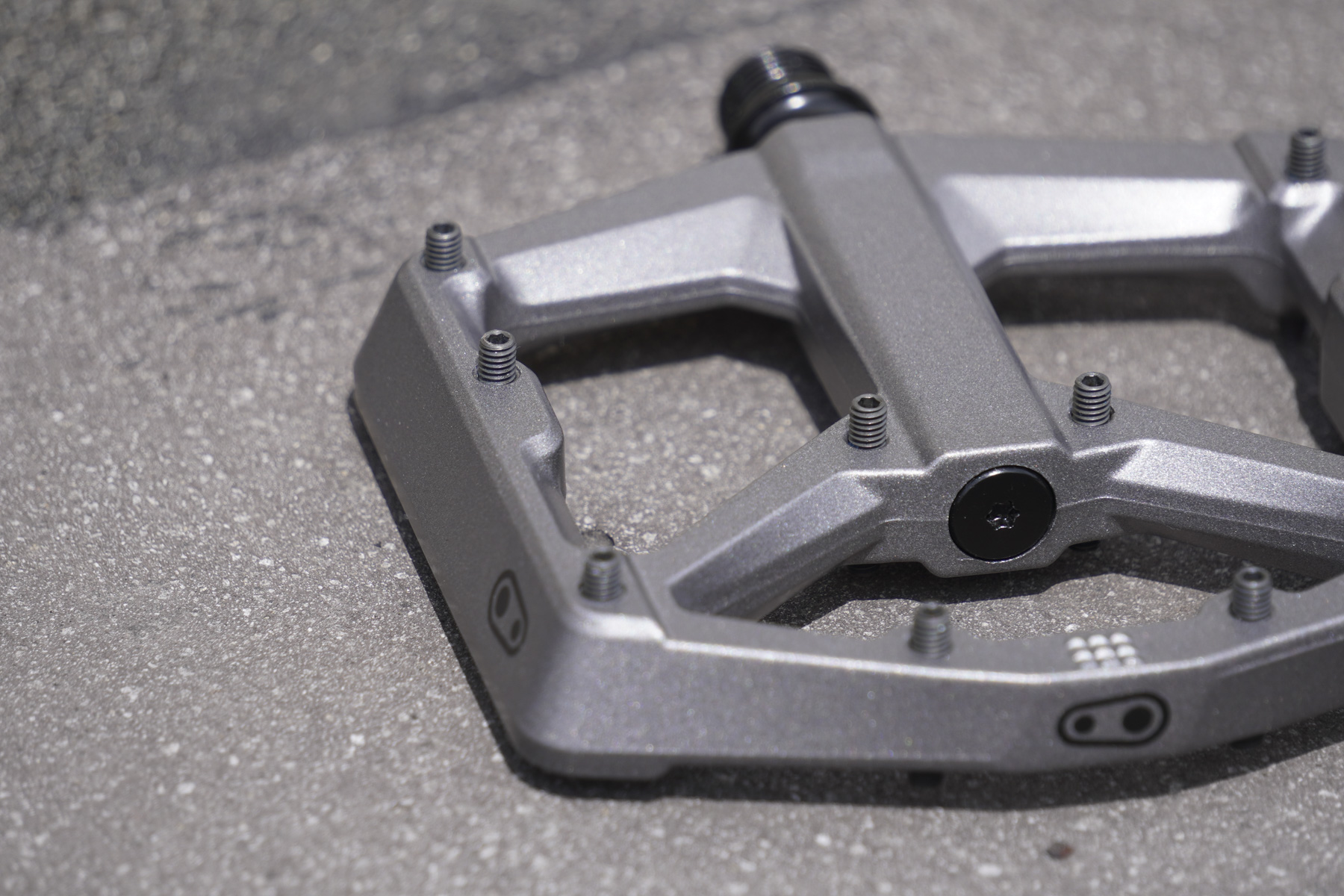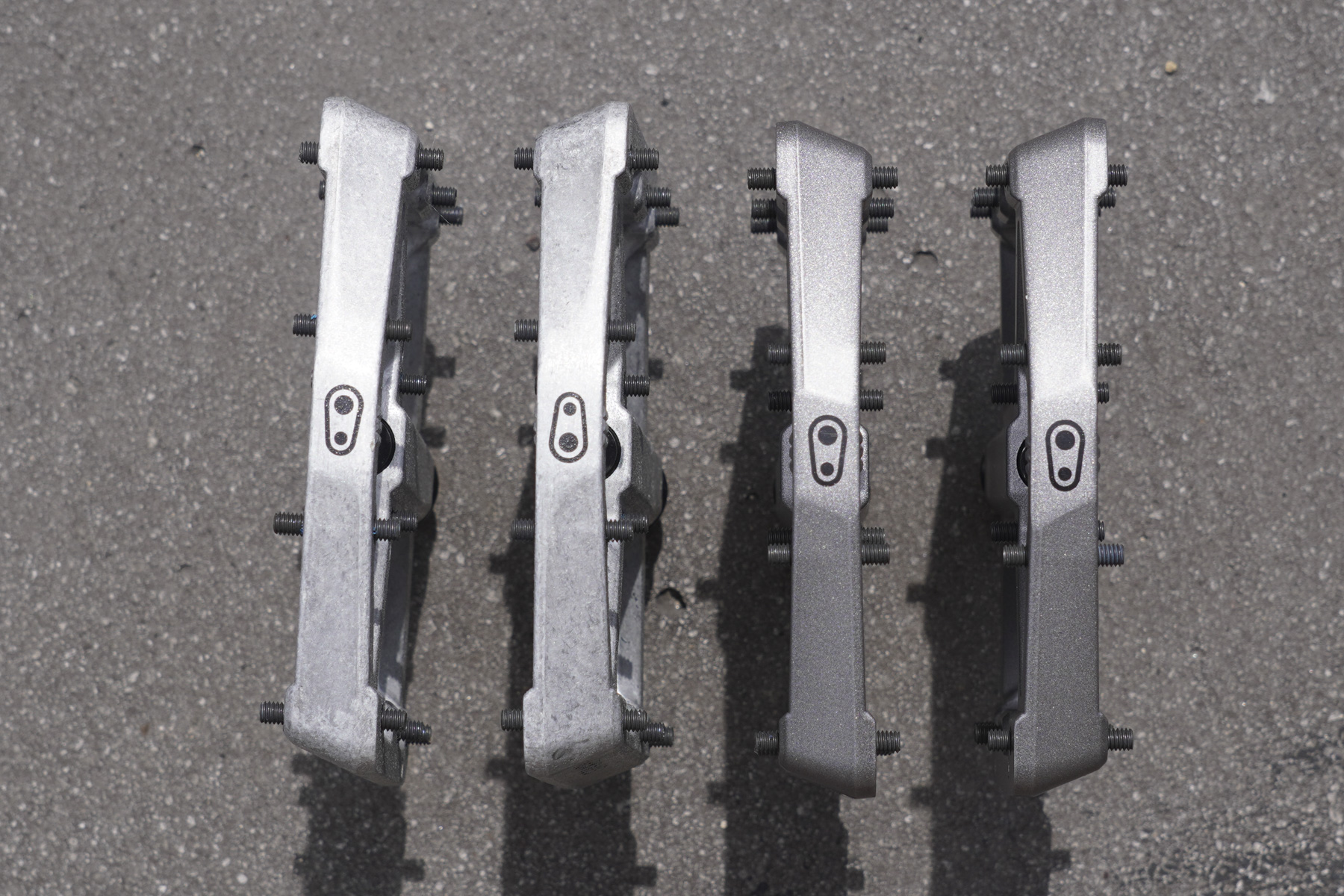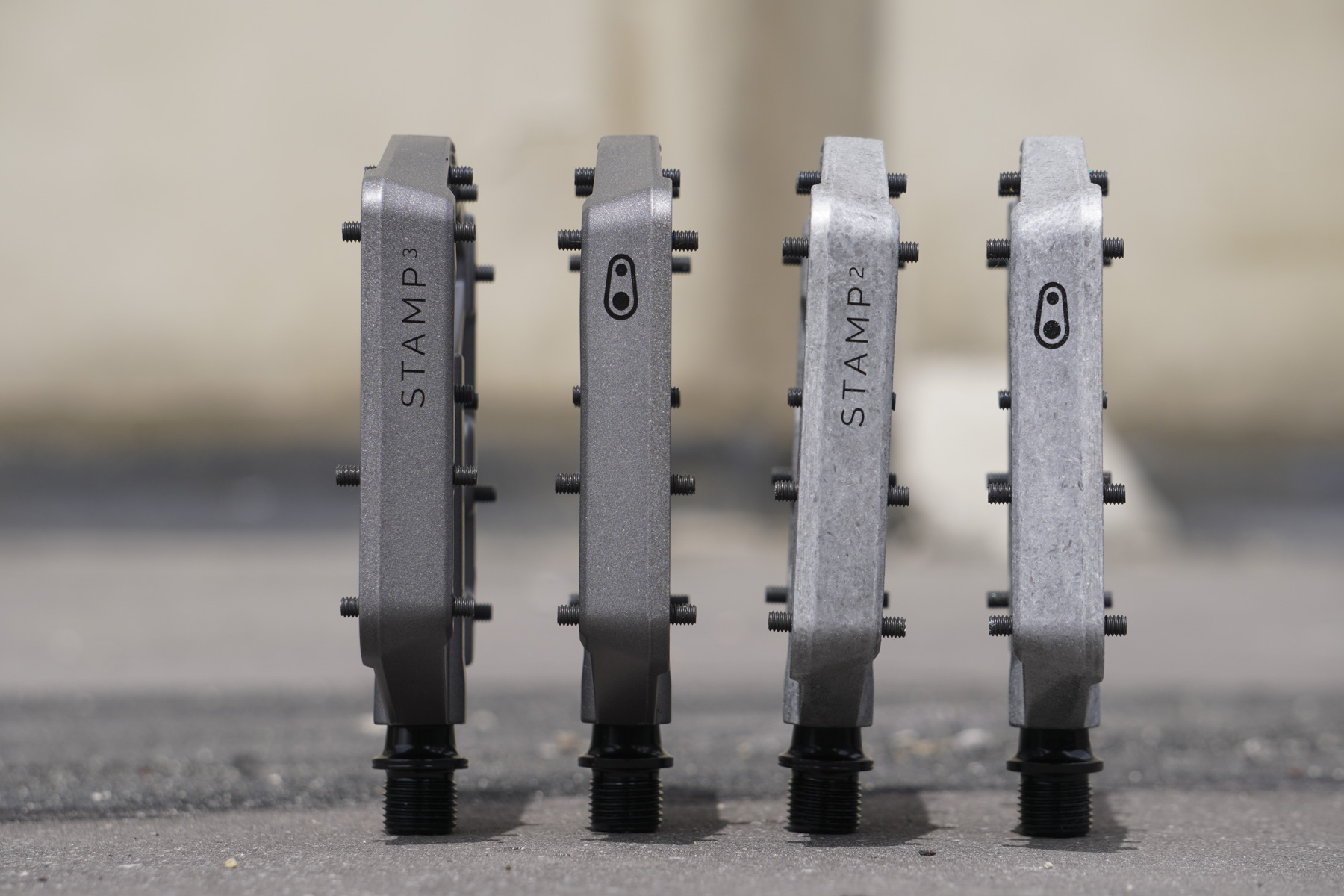We take a look at the latest flat pedals in the Crank Brothers Stamp range, and give five lucky readers a chance to win a pair.
Crank Brothers’ Stamp collection is its range of flat pedals. There are currently five models in the range, with some models offering a number of editions – such as the Stamp 7 Danny MacAskill, for those who want to emulate their hero.

Crank Brothers Stamp Range
- Stamp 1 – composite, entry level
- Stamp 2 – aluminium body, for trail, enduro and DH
- Stamp 3 – magnesium body, for trail, enduro and DH
- Stamp 7 – thinner, lighter and Forged 6061-T6 aluminium body, for enduro and DH
- Stamp 11 – pro level, titanium spindle, for enduro


What we have here are the latest iterations of the Stamp 2 and Stamp 3 pedals. Both share the same pedal profile and internal construction, but the body of the Crank Brothers Stamp 3 is made of much lighter magnesium (everybody: ooh!), while the Crank Brothers Stamp 2 has an aluminium body. Let’s look at the changes and features of these pedals.
On The Outside: Stamp 2 and Stamp 3 Pedals
As with all Crank Brothers flat pedals, these come in two sizes: Large and Small. Size Small is recommended for shoe sizes UK 4.5-9.5 (EU 37-42, US 5-10), with the Large being for size UK 9.5 (EU 43, US 10) and up. Matching the platform size to the shoe improves support to the foot while also ensuring that the contact between the shoe and pedal aligns nicely to the sole of your sticky shoes.


This year’s update has aimed to slim down the body of the Stamp 2 and Stamp 3 pedal while also increasing the concave profile. If you look at the previous models, it’s a single thickness pedal all the way across the body. This new model slims that right down from the centre housing the spindle, then includes a built up outer edge on which the two rows of three pins sit – giving the height needed for a concave shape without having bulk through the body of the pedal. Since the central pins sit on the new slimmed down part of the body, the concave shape is further accentuated – a welcome addition for most flat pedal riders.


The interface with the sole of your shoe can be given some further adjustment to suit your own preferences through giving the adjustable pins a turn or two. If there’s not enough flexibility using the pins provided, you can also buy the aftermarket 8mm pin packs to change things around. Out the box, all the pins are 10mm long – giving plenty of exposed pin to grip into your sticky soles. From the factory, they’re held in place with a dab of Loctite, so if you decide to adjust the pins it’s a good idea to add your own refresh of Loctite to make sure they stay in place in their new position. Pins can be adjusted using a 2.5mm Allen key, and are attached into the pedal (rather than through it) – so stick to blue Loctite rather than super strength red in case you need to remove worn pins later.

The placement of the pins has been changed from previous years, with the front and rear rows having two pins closer to the axle, rather than being equally spaced across the width of the pedal. In combination with the central pair of pins, this should give a good spread of contact points across the surface of the pedal.
Previous iterations of Stamp pedals have had horizontal cutouts inside the pedal body, which have given some users issues with mud retention. The new Stamp 2 and Stamp 3 bodies have angled internal chamfers rather than cut out shelves, offering the prospect of better mud shedding properties. The front edge of the pedal is angled to help is glance off rocks on the trail, rather than catching them.

As with other Crank Brothers pedals, you fit them to your bike using an 8mm Allen key – there’s no flat spot on the spindle for a pedal spanner. There is a teeny tine little ‘R’ and ‘L’ on the ends of the spindles to indicate which is the left and right pedal, and the left pedal has a double groove on the end of the spindle, whereas the right one is smooth. In addition, each pedal has different decals – the left states the model name and number in a pleasingly clean and modern font, while the right has a small Crank Brothers chainlink logo.
On The Inside: Crank Brothers Stamp 2 and Stamp 3 Pedals
Moving on to the internals, these remain the same as on previous models, with a steel spindle, an IGUS main bearing and enduro outer bearing. The IGUS bearing needs no lubrication, as it self lubricates as it wears – which is why it’s in there. While there’s no grease port, you can – and should – remove the end cap to give those enduro bearings some extra grease from time to time. Although the pedals come with a 5-year warranty on construction faults, you’ll still need to service them from time to time. Frequency of this servicing will depend on how often and in what conditions you’re riding, but we’ve found that recent test pedals from Crank Brothers have taken quite a beating without any water ingress. The end cap is removed using a star key – you’ll likely need a specific tool for this rather than a multitool, as the space to access the star head is quite tight. Where previous Stamp 2 and 3 pedals had a circle cut into the outer edge of the pedal body, with the new slimmer pedal profile this is omitted.

Choices, Choices…
While the Stamp 1 comes in an array of colours to match your bike, the Stamp 2 and Stamp 3 come in a choice of two colours each – though on the basis of previous form we might expect Crank Brothers to release further colours as time goes by. At present, the magnesium Stamp 3 comes in ‘grey’ or ‘black’. The ‘grey’ we have here is a smart looking finish, silky smooth, with a hint of robots from the future about it. The alloy Stamp 2 comes in ‘raw’ or ‘black’. We have the ‘raw’ here, and it’s more than just a colour – it’s a texture too. It really does have that industrial flecked raw metal or galvanised look, with a textured finish akin to skateboard grip tape. The overall effect makes it look like it’s come straight off the prototyping line and onto your bike.

Which pedal is right for you? Well, it’s going to come down to what you value. If weight saving is a must, then the magnesium bodies of the Stamp 3 keep the weight down to 395g for a large pair, while the large aluminium Stamp 2s weigh 500g. Remember – everything on the inside is the same, and the profile, size and shape of the body only differs in the magnesium vs aluminium material.
That weight saving comes at the expense of cost saving, with the Stamp 2 priced at £69.99 and the magnesium Stamp 3s at £109.99.
Crank Brothers Stamp 3 Features
- £109.99
- Magnesium Body
- Weight 395g (large, per pair)
- IGUS main bearing
- Enduro outer bearing
- Steel spindle
- 10 x 10mm adjustable traction pins
- Available in Grey or Black

Crank Brothers Stamp 2 Features
- £69.99
- Aluminium Body
- Weight 500g (large, per pair)
- IGUS main bearing
- Enduro outer bearing
- Steel spindle
- 10 x 10mm adjustable traction pins
- Available in Raw or Black

Magnesium of course sounds pretty cool, as well as being a touch lighter. It’s one of the earth’s most abundant metals – seawater contains loads of it – and it’s at the heart of all photosynthesis. Magnesium salts allegedly make for a nice soothing bath for tired muscles – although there’s no science to say that it’s any better for you than any other nice bath. It’s widely used in suspension forks – and historically (and briefly) used in Kirk Precision frames. Having magnesium pedals will give you the opportunity to deploy all these great conversation staters – and you probably can’t say the same for the aluminium version. Perhaps that will be the clincher for you: ‘do I want my pedals help me socialise, or just give me somewhere to put my feet?’.

Win a pair of Crank Brothers Stamp 2 or Stamp 3 pedals!
Thanks to UK Distributor Extra, we have five pairs of pedals to give away to lucky winners. These have been shipped directly to us from the factory, so they’re some of the first to arrive in the country. We have two pairs of small ‘grey’ Stamp 3 pedals, two pairs of large ‘raw’ Stamp 2 pedals, and one pair of large ‘grey’ Stamp 3 pedals.

All you need to do is answer the question below and submit your details.
Question: How much does a pair of large Stamp 3 pedals weigh?
The competition closes at midnight UK time on Sunday 19th July. We’ll announce the winner here and we will be in touch by email with the winner to ship them out to get you out and riding! Good luck!







This question can’t be answered.
The article gives the mass in grammes but then goes on to ask how much the *weigh*.
On the surface of the earth, at sea level, that’s easy enough to work out. But on the moon it will be about 20% of that.
If you are talking relativistic speeds, then it gets even more complicated (way beyond my pay grade tbh), but these things need to be considered – it could be a consideration for elite level riders.
I’ll need the size Large please;-)
And what about all the bling bling colours? Surely there’s gonna be more than just grey & black to choose from in the future…?
Mr Old and Past it, I suspect for ordinary every day purposes a weight measured here on earth will do.
As for relativity, on ordinary human scale of size and speed, we can be happy with Newtonian physics, even though we know it is wrong.
African or European?
After destroying a 2th set of DMR Vaults in a year i am more then happy with a pair of Large pedals
@kimbers PMSL! 😀
“The article gives the mass in grammes but then goes on to ask how much the *weigh*.”
Only they measured it on a top pan balance as can clearly be seen in the image so what has been measured is the weight despite the fact they’ve given that weight in fractions of a squirrel the mass hasn’t been given at all.
Also, if weight is defined as the force of gravity on an object, it’s impossible to truly lock that measurement down as the force of gravity will always be a variable…
Mystic Northwind predicts that the pins are going to come out of the magnesium bodies pretty easily.
The raw finish is lovely though
What do they weigh. Forgetting questions about weight in space we do need to know which size?
” Northwind July 10, 2020 at 1:47 am
Mystic Northwind predicts that the pins are going to come out of the magnesium bodies pretty easily. ”
but is that before or after the bearings self destruct?